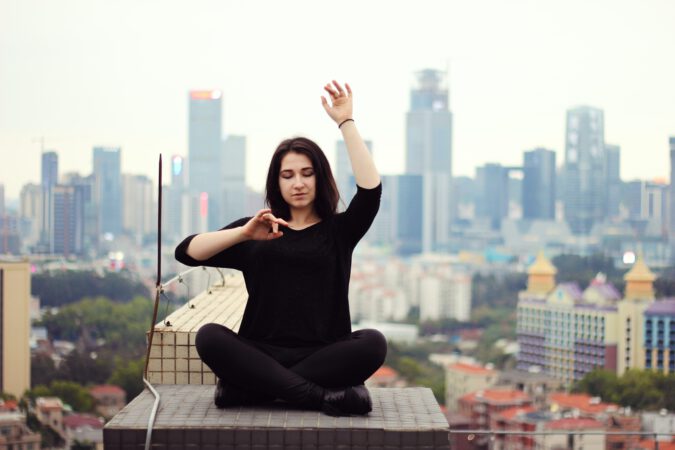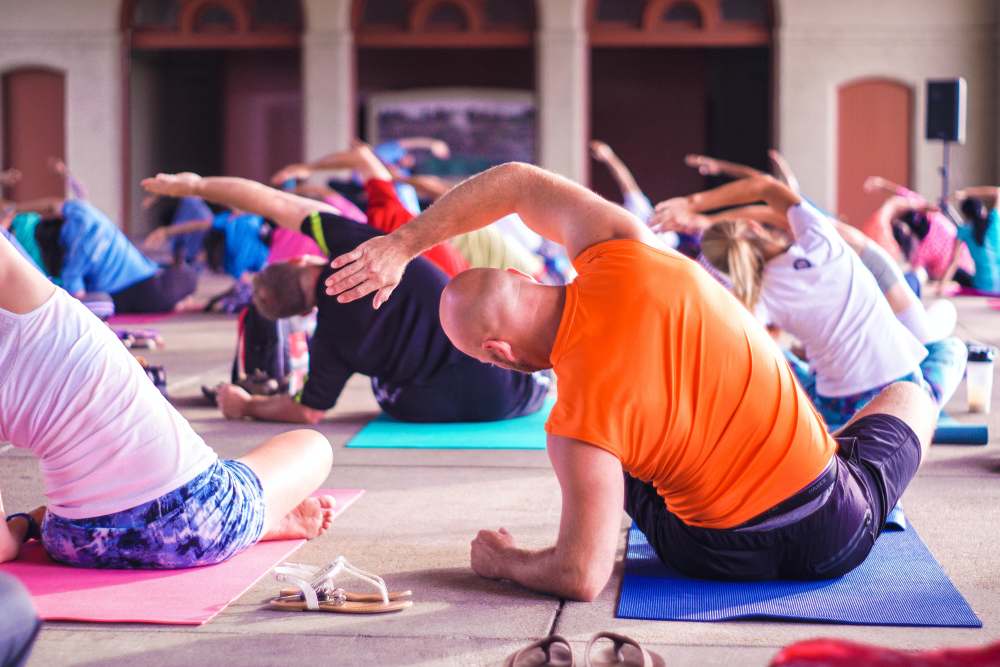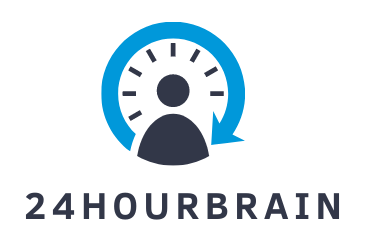Qigong – Bring the Body and Mind into Harmony
What Exactly is Qigong?
If you have ever walked through a Chinese park, you have probably come across them, the Qigong masters and their students. This is because Qigong is traditionally practiced in public places.
For years, Qigong has been a popular sport in China—though perhaps not the most appropriate word. Qigong is an essential component of traditional Chinese medicine.
It combines martial arts elements but is performed with slow, flowing movements. As a result, some people regard Qigong as a type of meditative movement.
Qigong literally translates to “work on Qi” (also called “Chi”). “Qi” refers to the universal life force that, according to traditional Chinese medicine, flows through the meridians, or body pathways. This has a positive effect on the practitioner’s brain and body!
The following benefits can be expected from regular Quigong practice:
- Enhancement of quality of life
- Mindfulness and concentration improvement
- The vegetative nervous system is regulated by this substance.
- Sensitivity improvement and self-perception enhancement
- Inner tensions are reduced.
- Perception of the body and its sensations has improved.
- Mind-calming and mental relaxation
- Increased joint mobility.
- Strengthening of the back muscles and spinal relief
- Deep abdominal breathing has a beneficial effect on circulation
Qigong’s Historical Significance
The roots of today’s Qi Gong can be traced back to the 4th century B.C., when various authors describe “exercises for life care” (Yangsheng) that are similar to Qigong.
Qigong was later refined, particularly during the late Zhou Dynasty (about 400 to 200 AD). Qigong rose to prominence in the 1950s and again in the 1980s.
Qi Gong (or Qigong, Chi gong) is derived from the words “Qi” (Chi) for life energy and “Gong” (Kung) for practice. The exercises are essentially “energy work.”

The Distinction Between Qigong and Tai Chi Chuan
Both Qigong and Tai-Chi Chuan (also known as Tai Chi, Taiji, or Taijiquan) have a long history in China and have evolved over the centuries.
Both are based on Daoist or Traditional Chinese Medicine thinking, and the life energy Qi, as well as the balance of various forces, play an important role (Yin and Yang, the five elements).
If you look at a series of Tai-Chi Chuan exercises, you would never guess that they were originally a martial art developed in ancient China for self-defense and close combat.
There are unarmed forms and movements performed with weapons and objects such as swords, fans, or sticks in Tai-Chi Chuan (also known as “shadow boxing”).
Tai-Chi Chuan is now practiced in China, primarily for health reasons. Tai-Chi Chuan also includes meditation and specific movements in which the practitioner concentrates on both his breathing and his movement.
Tai-Chi Chuan incorporates elements of Qigong, but it also includes longer forms, which are movement sequences composed of several elements.
For a Westerner, the subtle differences between Qigong and Tai-Chi Chuan are difficult to discern, and the transitions are fluid. Both movement teachings emphasize health, relaxation, and meditation.
How Does Qigong Function?
The life energy “Qi” or “Chi” is very important in traditional Chinese culture. It is envisioned as life energy flowing through energy pathways (meridians) and supplying various organ systems.
This energy accumulates in the area below the navel, the “gateway to heaven.” If the “Qi” flows smoothly, the person is healthy. If vital energy is depleted or accumulates in specific organs, it indicates indisposition and illness.
Qigong practitioners attempt to harmonize the “Qi” through movement and concentration in order to bring it into flow (again).
The Effects of Qigong on the Brain
Quigong is good for the brain due to its relaxing and balancing movements and the level of concentration required to practice it. Both together produce a high level of mindfulness.
Qigong is also excellent for regaining inner calm, concentration, and center-of-body stability. All of these effects have a positive impact on the brain.

Qigong Exercises
Many traditional exercises have poetic names, such as “Supporting the Sky with Your Hands.”
Qigong exercises are heavily influenced by nature. The practitioner imagines himself in the role of an animal (“The crane spreads its wings”) or meditatively places himself in nature, for example, by imagining himself firmly rooted like a pine tree.
Each of these exercises is said to have a different impact on life energy. Qigong exercises are designed to increase and circulate Qi. They should both promote health and strengthen mental balance.
How is Qigong Performed?
It is critical in Qigong to learn the movements precisely and to pay attention to the breathing. Various Qigong exercises, such as stillness and movement exercises, posture exercises, meditative concentration, and breathing exercises, are appropriate for this purpose.
Qigong exercises can be performed while lying, sitting, standing, or walking. The fundamental positions are simple to master and can be practiced almost anywhere.
The most well-known is the so-called “game of the five animals,” in which the five elements are assigned to the five animals based on their characteristics.
Thus, the ponderous bear represents earth, the graceful crane represents metal, the supple monkey represents water, the powerful tiger represents wood, and the dynamic deer represents fire.
These animals’ movements are imitated. This allows for the development of imagination and expression, as well as the expression of emotions in a playful manner. This is excellent for releasing pent-up rage.
The Brocades Exercise Series
The movements appear to be gentle and fluid. Qigong is inspired by nature; practitioners imagine themselves rooted like a tree or spreading their wings like a bird.
Other exercise series, such as “The 8 Brocades,” have names that are both figurative and lyrical.The brocade exercises are well-known in Qigong and are particularly suitable for beginners because they are simple to learn and address a wide range of individual body regions.
Even seasoned practitioners will find new ways to improve perception, posture, and breathing in the brocade series.
Qigong exercises can be performed indoors or outdoors, alone or in a group setting. It is true that videos can be used to teach Qigong exercises.
However, for a beginner, it makes sense to have a teacher teach the slow movements, concentration, and breathing exercises, as well as the meaning behind them. Experienced teachers will also consider physical ailments such as knee or back problems when selecting exercises.

Qigong at Home: An Introductory Exercise to Get Started
If you don’t want to commit to a class right away, you can always practice Qigong at home. In the following exercise, you gather your body energy so that you are both focused and relaxed. Just give it a shot!
Body Energy Gathering:
- Maintain a relaxed posture.
- Spread your weight evenly across your shoulders-width apart feet.
- Slightly bend your knees.
- Make a straight line with your spine. Push your pelvis forward very slightly to accomplish this.
- Then, gently lower your chin toward your chest. The back of your head will now be a straight extension of your back.
- Allow your shoulders to release tension.Your arms are relaxed at your sides.
- Place one hand on top of the other on the “lower dantian,” which is the area beneath the navel. This is the body’s energy center. Men place their left hand on their body, while women place their right hand on their body and their left hand on their right.
- Inhale quietly through your mouth and exhale quietly through your nose.
- Pay attention to the flow of your breath as you inhale and exhale.You’ll notice how your breath enters the middle dantian (the center of your chest) and raises and lowers your chest. You will gradually relax and drift off to sleep.
Repeat the exercise as many times as you want.

Conclusion
If you practice Qigong, you will notice many benefits for your body, but especially for your mind and brain. The important thing is to persevere and incorporate Qigong into your daily routine.
To begin, one should take a course that teaches the fundamentals of Qigong. Later, one can practice Qigong at any time and in any location.


